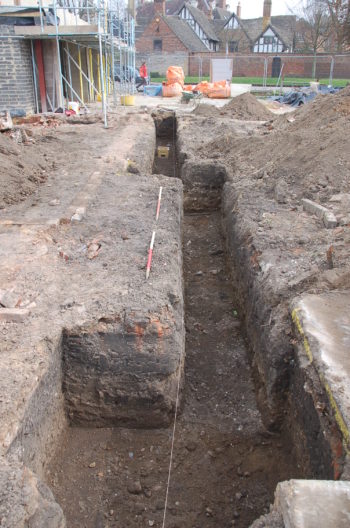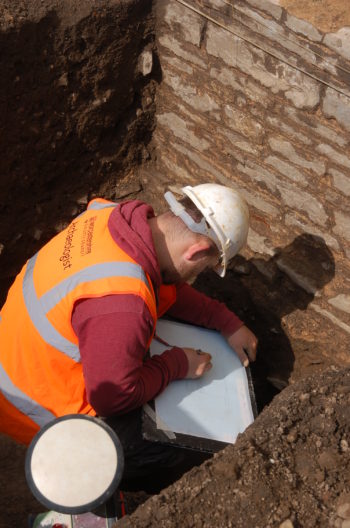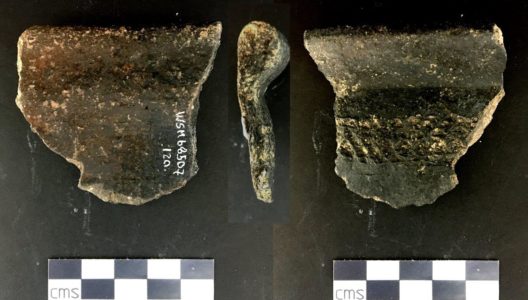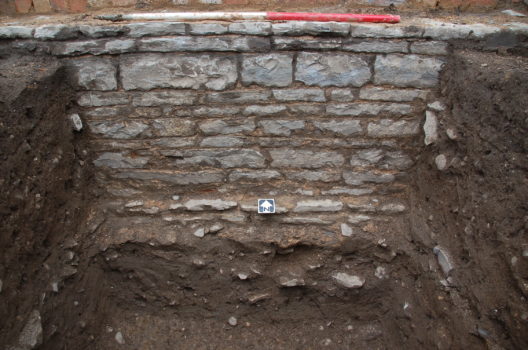The Great Wall of Evesham
- 16th June 2017
A well preserved section of Evesham Abbey’s outer precinct wall was uncovered recently. Late March saw one of our archaeologists, Jamie Wilkins, carrying out a Watching Brief[1] at the former Vauxhall Inn on Merstow Green, Evesham. The work, which was undertaken on behalf of Alan McColm and APU Retail Ltd, revealed a well-preserved section of the medieval wall, named after Abbot William de Chyryton, who ordered it to be built between 1317 and 1344.

Looking across the site towards the Almonry Museum
The wall, which originally ran from the Almonry, now a museum, across the south side of Merstow Green and down what is now Boat Lane to meet the River Avon, was very well preserved considering it is over 650 years old. It had been demolished to ground level and reused in the 19th century as a foundation for the side wall of what is now the Vauxhall Inn. Originally standing up to 12ft or nearly 3m high, the section under the Inn consisted of 12 courses of blue lias stone blocks set into a bed of sandy mortar standing to nearly 1m in height, although it is not known how much of this would have been visible above ground in the medieval period.

Archaeologist Jamie Wilkins recording a section of Abbot Chyryton’s wall that has been reused as a foundation for the rear wall of the 19th century Vauxhall Inn building
Other discoveries during the archaeological investigation included an unusual piece of decorated mid-11th to 12th century cooking pot, adding to evidence that the Saxon and medieval town was originally established around Merstow Green. Jamie also recorded a Roman yard or road surface underneath Abbot Chyryton’s Wall that along with the results of excavations at nearby Vine Street suggests that the late Saxon settlement outside the abbey gate, which in turn grew to become the medieval town, was established on an earlier Roman site.

An unusual decorated rim sherd of mid-11th to 12th century ‘Worcester type’ cooking pot
Abbot Chyryton’s Wall was built to replace an earlier ditch that marked the boundary between the town and the outer precinct, where the monks held land that they farmed to support themselves. In 1834 George May wrote in his History of Evesham that “…a strong and lofty wall stretching across, insulated the monastic domain from encroachment or intrusion on every side… The walling still easily be traced, it is in several places nearly entire, often 12 ft high and uniformly about 3 ft thick and in the governing charter of the borough is called the ‘Abbey Park Wall’. Another part of the wall was recorded in 1975 when the Merstow Green medical centre was built, while a short section on the south side of Boat Lane still stands to a height of nearly 2m.
Although Evesham Abbey was closed in 1539 as part of the Dissolution of the Monasteries the area within the former outer precinct has remained largely open and undeveloped up to the present day!

Abbot William de Chryrton’s Wall – built between 1317 and 1344
Historic Environment Advisor Adrian Scruby said “for such a small site the results of the archaeological work have been fantastic and really help to illustrate the rich history of the town”.
The results of the work will now be recorded in the Worcestershire Historic Environment Record and the report will be available online. Check back for updates on the availability of this report or follow our Twitter page for news of its publication.
[1] A Watching Brief is a method of preserving archaeological remains by recording them when they are revealed during development. An archaeologist is employed by the developer to monitor any works like the excavation of foundations and service trenches that might damage any remains that are present. The developer undertakes to give the archaeologist sufficient time to identify and record any archaeological finds and features that are revealed. A report is then produced on the investigation and the finds and site records (the project archive) are deposited with an appropriate museum and the report is made available through the Historic Environment Record.
Nice work and brilliant discovery. Thanks for sharing. My best regards to all at Worcester Archaeology where I once worked.